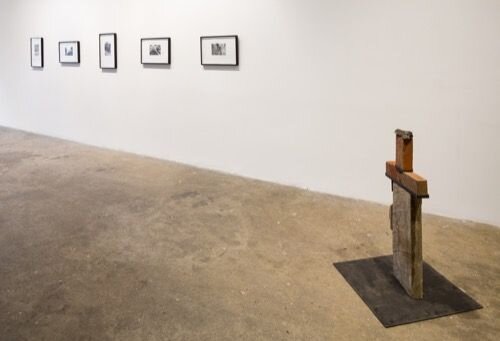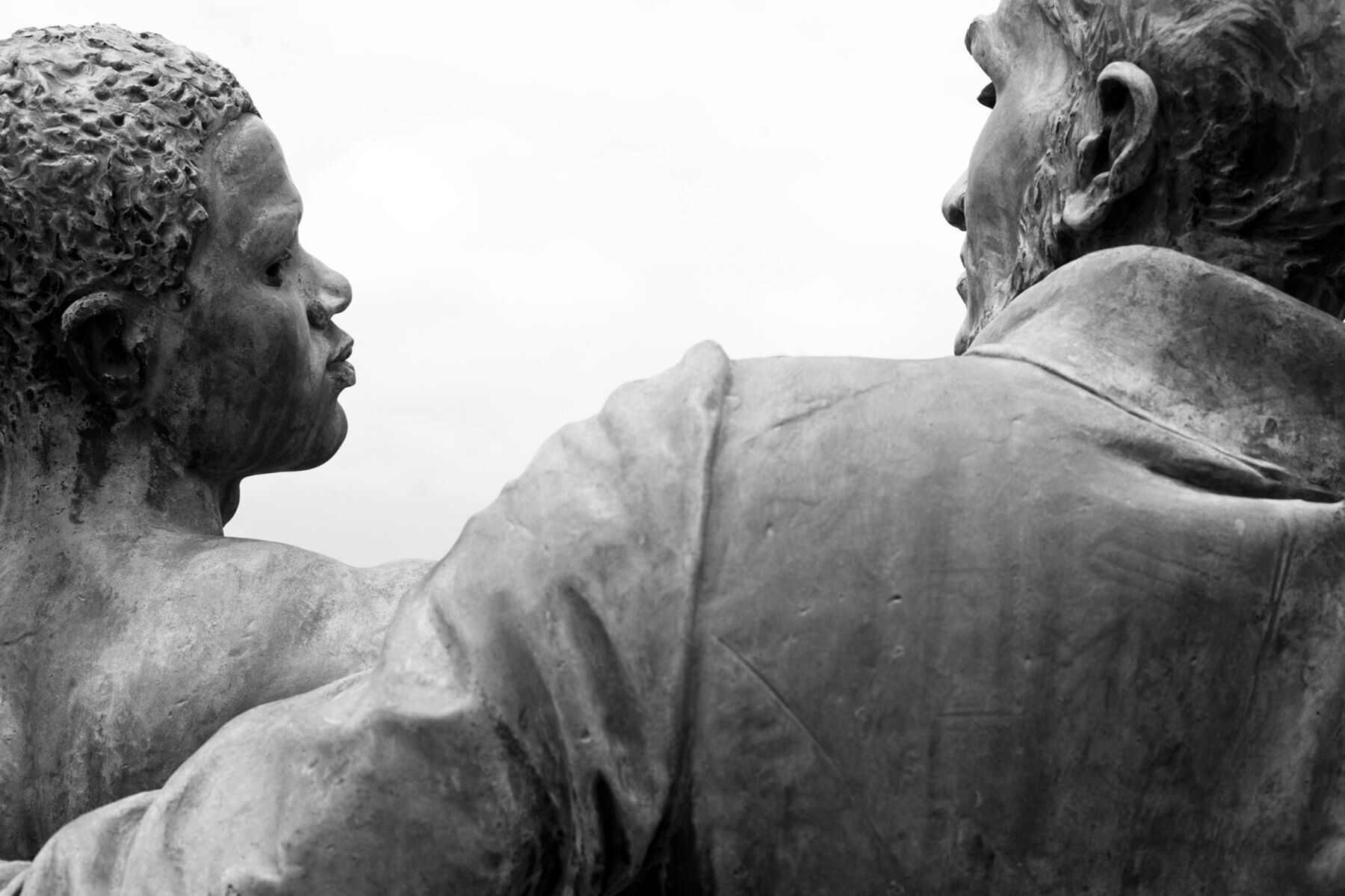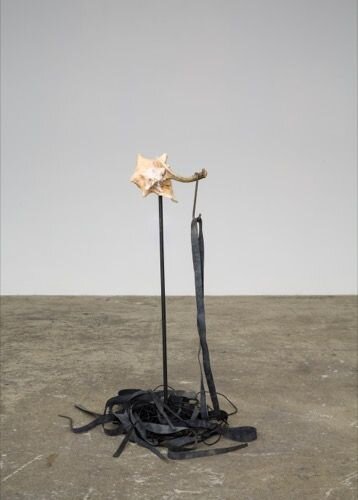The Coverly Set
May 24 – June 30, 2017
Mathieu K. Abonnenc and Ektor Garcia
January 13 – February 21, 2016
Sargent’s Daughters is pleased to present a two-person exhibit by Mathieu K. Abonnenc and Ektor Garcia. This will be the first New York exhibition for both artists and will be comprised of film, sculpture and a series of photogravures. This will also be the US premier of Abonnenc’s film Secteur IX A, 2015, which won the 17th Bâloise Art Prize awarded at his Art Basel Statements booth 2015; and his photogravure series Forever Weak and Ungrateful, which was on view in the Belgian Pavilion of the 56th Venice Biennale, 2015.
In Abonnenc ‘s series Forever Weak and Ungrateful, the artist concentrates on the analysis of a monumental statue of Victor Schœlcher by Louis Ernest Barrias in Cayenne, French Guiana, which represents the French colonial civil servant and member of Parliament as a heroic liberator of the slaves. Schœlcher was a French statesman and writer who worked to abolish slavery in French colonies and sculptures of him are common in the French West Indies, where Abonnenc was raised. We see Schoelcher showing the path to freedom to a slave whose shackles have just been loosed. Abonnenc focuses on the ambiguity of this representation—the figure of the slave is clad only in a loincloth, while his liberator is fully dressed. Schoelcher’s grand gesture and paternalistic look appears at first in direct contrast to the slave’s humbled position and grateful gaze, but the boundaries between them and issues such as dependence and exploitation are not so clear. Abonnenc’s discerning edits reveal the complexity of the relationship between a patronizing and a fetishizing approach by concentrating on the details of the sculpture to reveal a larger picture of various colonial and postcolonial interpretations, calling into question the nature of desire and freedom.
In his film Secteur IX A, 2015, Abonnenc discusses the origins of the the ethnographical objects collected by his grandfather Emile Abonnenc, while making a connection to his grandfather’s collecting activities in the early 1930s and the theories of the French surrealist poet, writer and ethnographer Michel Leiris. The film is mysterious and poetic, with no real dialogue and a dreamlike quality. Photographs of ethnographic objects, as well as objects themselves, which orbit in the semi-darkness like peculiar planets, appear and re-appear throughout the film. In one photograph we see a group of men wearing tribal masks, moments later these masks appear arranged in a museum case on display. Abonnenc’s interest in the personal implications of a collective colonial history are woven through the film and serve to illuminate as well as obfuscate the meaning that of a shared history.
Ektor Garcia’s sculptures incorporate traditionally Mexican craft elements such as crochet lace and woven leather with found objects in an arrangement suggestive of altars and talismans while referencing eroticism, power, borderlines, survival, resistance and desire. The objects have elements of ritual and familiarity: a pair of antlers rests on a vise clamp, which balances atop a delicate lace doily like a grandmother’s favorite object. This reference to a fragile equilibrium appears throughout Garcia’s works. They are partially cultural appropriation and partially fantastic invention, and speak as much to Garcia’s upbringing between Mexico and the US as to larger issues of social justice and labor practice. Garcia’s autobiography and family history haunt and inspire everything he does, and his personal history is deeply entwined with the larger political history of cultural commodification and appropriation between the US and Mexico.
Similarly to Abonnenc’s objects floating in his film, untethered in space, Garcia’s sculptures place familiar components in unusual arrangements, letting them loose from an orthodox reading. By allowing the objects to exist as two things at once (a cultural specimen as well as an piece of art) the associations with the objects necessarily transform from direct to indirect. Garcia’s rendering of a child in quotidian materials permits a similarly unusual view to Abonnenc’s photographic editing of a historical statue. Both artists have a deep connection, and understanding of, historical interpretations of ethnographic objects and the history of colonial heritage that remains an enduring legacy of both the US and France. Through artistic investigation and research Abonnenc and Garcia both confront the ongoing consequences of a colonial past that is personal and universal, using history to illuminate the present and shed light on the circumstances that inform and direct these lasting discussions.
Mathieu Kleyebe Abonnenc was born in 1977 and lives and works in Metz, France. He has had personal exhibitions at Kunsthalle Basel and Bielefelder Kunstverein in 2013 and at the Serralves Foundation, Porto, in 2012. He participated to the 8th Berlin Biennale (2014), to the Triennale, Paris (2012) and to Manifesta 8 (2010). Recent solo exhibitions include Chimen chyen at Marcelle Alix, Paris, FR. His work was recently shown at the occasion of the exhibition Leiris and co at Centre Pompidou Metz, at the Venice Biennale (international exhibition and Belgian pavilion) and at the Kiev Biennale. His film Secteur IX B (redshoes production) was selected by the TIFF festival, Toronto and was screened at Tate Modern in July. Mathieu K. Abonnenc received the Bâloise Art Prize at Art Basel 2015, thanks to which the Museum für Moderne Kunst (MMK) in Frankfurt will organize a solo exhibition of his work in 2016. The Pompidou in Paris devoted a Prospectif Cinéma screening to the artist on Sept 24, 2015. Abonnenc is represented by Marcelle Alix, Paris, FR.
Ektor Garcia was born in 1985 in Red Bluff, California. A child of migrant farm workers, he has lived and traveled frequently between California and Mexico. Ektor received his BFA from The School of the Art Institute of Chicago in Fiber and Material Studies in 2014 and is currently an MFA candidate at Columbia University. He has had a solo show at Touché, a gay leather bar in Chicago, IL. He lives and works in New York City.













